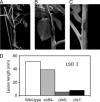Genome sequence of the enterobacterial phytopathogen Erwinia carotovora subsp. atroseptica and characterization of virulence factors
- PMID: 15263089
- PMCID: PMC503747
- DOI: 10.1073/pnas.0402424101
Genome sequence of the enterobacterial phytopathogen Erwinia carotovora subsp. atroseptica and characterization of virulence factors
Abstract
The bacterial family Enterobacteriaceae is notable for its well studied human pathogens, including Salmonella, Yersinia, Shigella, and Escherichia spp. However, it also contains several plant pathogens. We report the genome sequence of a plant pathogenic enterobacterium, Erwinia carotovora subsp. atroseptica (Eca) strain SCRI1043, the causative agent of soft rot and blackleg potato diseases. Approximately 33% of Eca genes are not shared with sequenced enterobacterial human pathogens, including some predicted to facilitate unexpected metabolic traits, such as nitrogen fixation and opine catabolism. This proportion of genes also contains an overrepresentation of pathogenicity determinants, including possible horizontally acquired gene clusters for putative type IV secretion and polyketide phytotoxin synthesis. To investigate whether these gene clusters play a role in the disease process, an arrayed set of insertional mutants was generated, and mutations were identified. Plant bioassays showed that these mutants were significantly reduced in virulence, demonstrating both the presence of novel pathogenicity determinants in Eca, and the impact of functional genomics in expanding our understanding of phytopathogenicity in the Enterobacteriaceae.
Figures




References
-
- Blattner, F. R., Plunkett G., Bloch, C. A., Perna, N. T., Burland, V., Riley, M., ColladoVides, J., Glasner, J. D., Rode, C. K., Mayhew, G. F., et al. (1997) Science 277, 1453–1462. - PubMed
-
- Perna, N. T., Plunkett, G., Burland, V., Mau, B., Glasner, J. D., Rose, D. J., Mayhew, G. F., Evans, P. S., Gregor, J., Kirkpatrick, H. A, et al. (2001) Nature 409, 529–533. - PubMed
-
- Parkhill, J., Dougan, G., James, K. D., Thomson, N. R., Pickard, D., Wain, J., Churcher, C., Mungall, K. L., Bentley, S. D., Holden, M. T., et al. (2001) Nature 413, 848–852. - PubMed
-
- Parkhill, J., Wren, B. W., Thomson, N. R., Titball, R. W., Holden, M. T., Prentise, M. B., Sebaihia, M., James, K. D., Churcher, C., Mungall, K. L., et al. (2001) Nature 413, 523–527. - PubMed
Publication types
MeSH terms
Substances
Associated data
- Actions
Grants and funding
LinkOut - more resources
Full Text Sources
Other Literature Sources
Molecular Biology Databases
Miscellaneous

